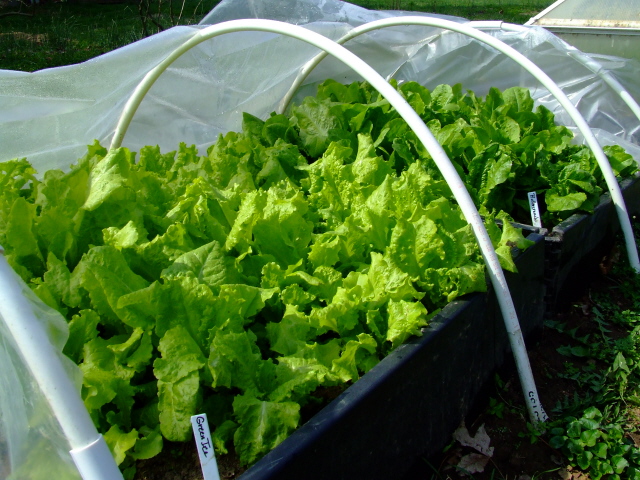Lettuce Grow Fall Salad Greens

Summer’s end is no reason to stop enjoying garden fresh salads. Many kinds of greens grow well in the cooler days of fall and are less likely to bolt, or go to seed, giving you an extended harvest. Even in cold winter climates, if you give your greens some frost protection with a cold frame, row cover, or low tunnel, you may be able to keep up the harvest until late fall or even winter. Plus this is a great chance to broaden your culinary horizons by growing some of the more unusual and less familiar hardy greens. So get planting and go green this fall!
Old Standby’s
Lettuce
This is a great fall crop because it grows well when soil temperatures are cool and daylegths are getting shorter. One problem you may encounter when sowing lettuce for fall harvest is poor germination due to high soil temperatures when you direct seed in late summer and early fall, especially in southern gardens. One way around this problem is to sow seeds indoors in flats or pots, transplanting seedlings to the garden when they are a few inches tall. Or you can shade the lettuce bed for a week or so before planting so the soil is a little cooler when you sow your seeds.
In northern gardens, begin seeding your fall lettuce in early August, making twice weekly succession plantings up until about mid-October for quick-maturing leafy varieties. Gardeners in the central parts of the country can begin sowing seeds in early September, continuing with succession plantings until frosts come. And in southern areas, you may be able to plant succession crops from October through March.
Spinach
Popeye’s pick makes a great fall crop in most areas. Spinach relishes the cooler weather, and decreasing daylengths don’t trigger bolting. In cold winter areas, sow seeds about 8 weeks before hard frosts (below 28 degrees F) are due to hit. Southern gardeners can usually harvest spinach through December or even later in the warmest areas. Make successive sowings every 2-3 weeks throughout the fall.
To get an extra early harvest next spring, plant your spinach seeds in the late fall, just before the ground freezes. The seeds will lie dormant in the soil over the winter and sprout as soon as conditions are right in the spring. Often they’ll germinate and grow when the ground is still too wet to be worked, which can delay spring planting. You may get a lower germination rate, depending on weather conditions over the winter, but if you’re willing to take a bit of a gamble, you can often enjoy an extra-early spinach harvest from fall-sown seeds. Another technique for early harvest next growing season is to sow spinach seeds about 6 weeks before your expected frost in the fall. The plants will germinate and make a little bit of growth. Before hard frost hits, cover baby plants with heavy-weight row cover fabric and keep the protection on over the winter. Remove the covering in early spring as plants come back into active growth. This will often give you about a six week jump on a spring-planted crop.
Something a Little Different
Arugula
This peppery green is equally delicious in a salad or a stir-fry. Unlike spring-planted arugula, a fall crop won’t bolt as readily and become bitter and unpalatable. Sow seeds every couple of weeks from late summer until about a month before hard frost. Give plants a steady supply of water for the best flavor.
Corn Salad
Also known as mache, this mild-tasting green is extremely hardy, so make successive sowings every 2 weeks up until around the time of the first frost date. Seeds may be slow to germinate (10-14 days). You can harvest individual leaves or the entire plant by cutting off the plants at ground level. You may get a second harvest from the cut stub. If given some protection, corn salad may be harvested into the winter. Plants may even overwinter for an extra-early spring crop.
Swiss Chard
In mild-winters areas such as the Deep South, Southwest, and southern California, nutritious chard can be sown in late summer and fall for late fall and winter harvest. Gardeners throughout the Southeast may able to harvest well into the winter if plants are protected by low tunnels or cold frames.
Mustard
Spice up salads with the peppery bite of easy-to-grow baby mustard greens. In late summer to mid fall, plant either in a cold frame or directly in the garden.
Napa Chinese Cabbage
This tall, upright, mild flavored cabbage generally does best as a fall crop in most parts of the country, when it is less likely to bolt quickly. Depending on your climate, plant seeds from early August in cooler areas to September or October in mild winter climates, or about 8-12 weeks before your fall frost date.
Asian Greens
There are many choices to explore in this category. Try mizuna, a mild Asian green with a slightly peppery taste that can be added to salads or stir-fries. Sow seeds of this hardy crop in late summer to early fall. Taht soi is another cold hardy Asian green with a mild mustardy flavor and slightly crunchy texture. For fall crops, plant from midsummer up to about 5 weeks before your hard frost date.
Kale
This hardy crop shrugs off frosty weather. To harvest at full maturity, sow seeds about 10-12 weeks before fall frost. To pick kale as baby greens for salads, sow seeds in succession from late summer to mid fall, depending on your climate.
Claytonia
Also known as miner’s lettuce, this is one of the hardiest of the salad greens. It has small, delicate, succulent leaves with a very mild flavor. In cooler areas, sow seeds in early fall; if grown with the protection of a cold frame, the harvest may continue through the winter. Gardeners in milder climates can sow claytonia seeds in late fall for winter and early spring harvest.
Minutina
This very cold hardy green forms rosettes of slender, crunchy, green leaves that add interest to winter salads, along with edible flower buds. Even in cold climates, it will take some frost and often survive the winter if given some protection.
By:Susan Littlefield is the horticultural editor for the National Gardening Association.
http://www.garden.org/articles/articles.php?q=show&id=3962



Leave a Reply
You must be logged in to post a comment.